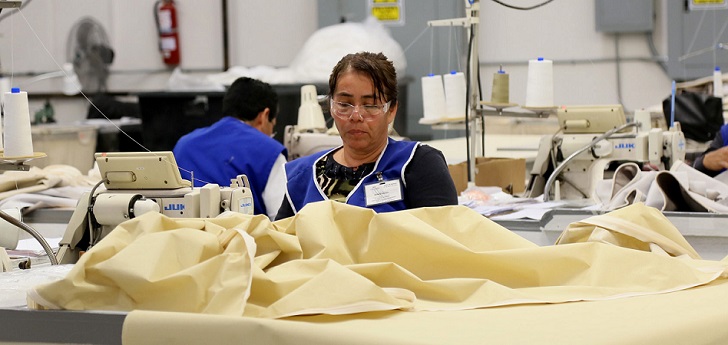The coronavirus lifts the ‘made in Mexico’: orders pick up amid crisis in China
Due to the outbreak of the virus, Mexican textile, the main hub in proximity to the United States, is starting to become a refuge to quickly cover an international demand.

Industrial activity recovers in Mexico due to the coronavirus. Mexican fashion and textile manufacturers report a slight increase in orders and quotes from US companies because of the increasing closure of factories in China, the main sourcing country for international fashion companies.
US retailers seek to quickly stock up in the face of the health crisis that threatens the spring-summer collections and puts the fall-winter season at risk, the biggest season of the year. Mexico, the main hub in the vicinity for the industry in the United States, begins to gain prominence on the sourcing map of international fashion. So far, the country has confirmed five cases of the virus.
China currently exports $157.8 billion in clothing each year. However, Mexico remains the third-largest fashion supplier in the United States behind China and Canada. According to information published by the National Chamber of the Mexican Textile Industry (Canaintex), in 2019, 60% of the country’s total textile exports went to the United States, where 91.8% accounted for clothing.
Mexico is the third-largest fashion provider in the United States, only behind China and Canada
According to Jorge Plata, CEO of Argentum Textil, a company specialized in textile spinning and manufacturing and former president of the Mexican National Textile Industry Chamber, the interest of international companies is can already be noticed. The executive says that “they have received emails and calls from several customers who would like to resubmit their production in Mexico, specifically from distribution companies of denim, and sportswear, a sector that is going through a boom in the United States,” says Plata.
In contrast, Kaltex, a Mexican company specializing in the production of yarn, cloth, synthetic fibers, states that only 10% of its sales come from the United States. The company, which mainly sells T-shirts to the North American country, affirms that in the last months the number of orders from the North country has remained constant and that few North American companies have called for information about the productive capacity.
Grupo Miró, a company specialized in the distribution of knitted fabrics, says that although the volume of orders from the North American country has remained stable, there is an increase in calls for quotes and search for suppliers by potential North American customers.
The main productive poles of Mexico are the State of Mexico, Guanajuato, Puebla, Jalisco and Yucatán
According to Elisa Vega, head of product development of the group, “the increase in orders could be increasing in the short term, as many of its customers buy in Asia and especially in China,” says the executive. In fact, a few weeks ago the company was contacted by an American company that centralizes all the manufacturing of its pajamas in China, in search of quotes for its production.
But are Mexican manufacturers ready to respond to a demand previously met by China? According to Plata, the installed capacity in Mexico is enough, and there is “a constant increase in investment in technology and production capacity.” If the demand takes a significant boost, “local manufacturing and supply companies will have more freedom to choose which projects they choose, which would improve production effectiveness,” says the executive.
Specifically, the denim sector is very well structured in Mexico, with a high level of automation and significant growth in recent years. The main productive poles of the country are the State of Mexico, Guanajuato, Puebla, Jalisco and Yucatán. In the south, Mérida is gaining strength in the clothing sector.
Because of its proximity to the United States, Mexico can have a truck at the border in 48 hours
However, the region is still at a disadvantage compared to countries such as Bangladesh or India in terms of production cost, supplies, operating costs, and labor force, among others. The increase in demand for Mexican production could cause obstacles when companies expect to obtain the same costs they pay in Chinese factories. As Silver explains, in that case the Mexican industry would have to focus on its efficiency and closeness advantages.
Precisely, one of Mexico’s main competitive advantages with Asian countries is the rapid response to the United States. Depending on the location of the factory you are working with, the border is eight or ten hours away. Mexico can have a truck at the border in 48 hours.
The Mexican textile industry is one of the main suppliers of internationals such as Levi’s, Guess, Tommy Hilfiger, and others
In the case of jeans, when the fabric is produced in Mexico, jeans are one of the products most benefited by the new North American free trade agreement, since they comply with the rules of origin stipulated in the agreement, which It means that the final product can avoid paying tariffs with its neighbors Canada and the United States.
Since the USMCA was signed in 1994, Mexico multiplied its exchanges with the United States by five, benefiting around 14 million workers. In the fashion sector, the USMCA emphasizes that each of its members should progressively eliminate tariffs on textile and clothing. The Mexican textile industry is one of the main suppliers of international brands such as Levi’s, Guess, Tommy Hilfiger, Gap and others.


info@themds.com
Validation policy for comments:
MDS does not perform prior verification for the publication of comments. However, to prevent anonymous comments from affecting the rights of third parties without the ability to reply, all comments require a valid email address, which won’t be visible or shared.
Enter your name and email address to be able to comment on this news: once you click on the link you will find within your verification email, your comment will be published.